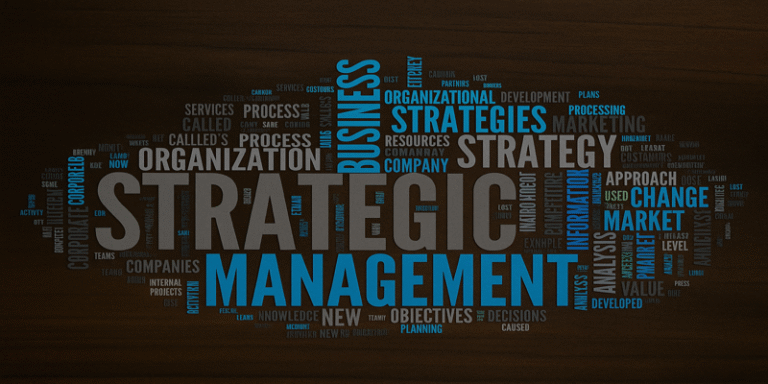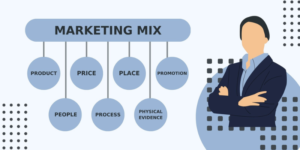Strategic management is a systematic process that involves the formulation, implementation, and evaluation of actions and initiatives aimed at achieving an organisation’s long-term objectives (David, 2021). By aligning an organisation’s resources and capabilities with its mission, vision, and goals, strategic management provides a comprehensive framework for navigating an ever-evolving business environment. Organisations that excel in strategic management maintain a competitive advantage, ensuring long-term success and sustainability.
This article explores the key components of strategic management, offering a comprehensive understanding of how each contributes to the overall strategy process. From setting objectives to adapting to changes in the external environment, each step ensures that organisational efforts are aligned toward achieving strategic goals.
1.0 Setting Objectives
Setting clear, specific, and measurable objectives is the foundation of effective strategic management. Objectives should adhere to the SMART criteria, meaning they are Specific, Measurable, Achievable, Relevant, and Time-bound (Wheelen and Hunger, 2020). These objectives serve as a navigational tool for an organisation’s decision-making and performance assessment.
To establish strategic direction, organisations must define a clear mission and vision. The mission statement outlines the organisation’s core purpose, whereas the vision articulates its long-term aspirations. Aligning SMART objectives with mission and vision statements enables a structured roadmap that ensures clarity and purpose across all levels of the organisation (Hitt, Ireland and Hoskisson, 2021).
For instance, multinational corporations like Unilever set both financial and non-financial objectives, measuring success through profitability, market share, and corporate social responsibility (CSR). Clear objectives also support performance measurement, enabling continuous monitoring and adjustment when needed.
2.0 External Environment Analysis
The external environment significantly influences an organisation’s strategic choices. Understanding external forces helps managers identify opportunities and threats that could affect long-term viability. Tools such as SWOT analysis (Strengths, Weaknesses, Opportunities, and Threats) and PESTEL analysis (Political, Economic, Social, Technological, Environmental, and Legal factors) are instrumental for evaluating the macro-environmental context (Barney and Hesterly, 2019).
A comprehensive external analysis enables firms to anticipate market trends, respond to technological advancements, and adapt to socio-economic shifts. For example, the increasing emphasis on sustainability and digitalisation has driven companies like Tesla and IKEA to align strategies with environmental innovation and renewable energy initiatives (Grant, 2019). Conversely, failure to anticipate environmental or regulatory shifts—such as those caused by Brexit or the COVID-19 pandemic—can result in strategic setbacks.
3.0 Internal Analysis
While external analysis identifies external influences, internal analysis evaluates the organisation’s internal environment, including its resources, capabilities, and competencies. According to the Resource-Based View (RBV), sustainable competitive advantage arises from resources that are valuable, rare, inimitable, and non-substitutable (Grant, 2019).
Internal analysis involves assessing key functional areas such as financial health, operational efficiency, human resources, and organisational culture. Identifying core competencies—activities or processes that provide a unique competitive advantage—is essential (Hitt, Ireland and Hoskisson, 2021). For example, Toyota’s lean manufacturing system exemplifies a core competency that enhances operational efficiency and product quality. Similarly, Google’s innovation culture supports continuous product development, enabling it to dominate the technology industry.
Internal analysis also highlights weaknesses. A company might excel in marketing but lag in logistics, prompting investment in supply chain management or digital infrastructure to improve efficiency.
4.0 Industry and Sector Analysis
An industry and sector analysis provides deeper insight into the competitive dynamics and structural forces shaping an organisation’s operating environment. Michael Porter’s Five Forces Framework remains a cornerstone for understanding industry structure, focusing on competitive rivalry, threat of new entrants, bargaining power of suppliers, bargaining power of buyers, and threat of substitutes (Porter, 1985, cited in Barney and Hesterly, 2019).
Analysing these forces enables organisations to evaluate profitability potential and strategic positioning. For instance, the airline industry faces high competitive rivalry and powerful buyers, leading to thin profit margins. In contrast, the pharmaceutical sector benefits from strong barriers to entry due to regulatory constraints and patent protection.
Emerging industries such as renewable energy or artificial intelligence (AI) also demonstrate how technological shifts can reshape competitive structures, creating new market opportunities and challenges. By understanding these dynamics, organisations can make informed decisions regarding market entry, pricing, and innovation strategies.
5.0 Strategy Formulation
Strategy formulation entails determining how best to allocate organisational resources to achieve strategic objectives. Firms choose among different generic strategies—cost leadership, differentiation, and focus—depending on their strengths and market conditions (Porter, 1985).
- Cost leadership aims to achieve the lowest operational costs, as demonstrated by Aldi and Ryanair, which offer high value at low prices through operational efficiency.
- Differentiation focuses on unique products or services, exemplified by Rolls-Royce and Apple, which command premium prices due to perceived quality and innovation.
- Focus strategies target niche markets, tailoring offerings to specific customer segments.
At the corporate level, strategy formulation includes diversification, mergers and acquisitions, and strategic alliances. For instance, Disney’s acquisition of Pixar allowed it to expand into computer-animated films, strengthening its brand and market share (Wheelen and Hunger, 2020).
6.0 Strategy Implementation
The success of any strategy depends on effective implementation. This stage involves aligning resources, organisational structures, and culture with strategic objectives. Key enablers include leadership commitment, communication, and change management (Rothaermel, 2020).
For example, Apple’s successful launch of the iPhone was underpinned by integrated efforts across design, engineering, and marketing, supported by a culture of innovation. Conversely, strategies often fail due to misalignment between strategy and structure—for instance, when a bureaucratic culture inhibits agility and innovation.
Ensuring employees understand their roles in executing strategy fosters engagement and accountability. Effective leaders create a shared vision that aligns with organisational goals, promoting commitment across all levels.
7.0 Strategic Control and Evaluation
Strategic control and evaluation are vital for assessing whether a strategy achieves its intended results. Performance metrics such as Key Performance Indicators (KPIs) and benchmarking enable organisations to track progress and identify areas for improvement (Hitt, Ireland and Hoskisson, 2021).
The Balanced Scorecard (BSC), developed by Kaplan and Norton (1996), extends beyond financial measures to include customer satisfaction, internal processes, and learning and growth. For example, companies like Siemens and Unilever use BSCs to integrate sustainability and innovation into their performance metrics. Regular strategic reviews help organisations remain agile, reallocating resources or refining objectives as necessary (Rumelt, Schendel and Teece, 2019).
8.0 Adaptation
In today’s dynamic business environment, strategic adaptation is crucial for long-term survival. Organisations must proactively adjust strategies to respond to technological, social, and economic disruptions. Firms like Netflix exemplify strategic adaptation, evolving from a DVD rental business to a global streaming and content creation platform. In contrast, Blockbuster’s failure to adapt led to its decline (Rumelt, Schendel and Teece, 2019).
Adaptation extends beyond structural change; it encompasses cultural agility, learning, and innovation (Barney and Hesterly, 2019). Organisations that embrace change as an opportunity rather than a threat can sustain their competitive advantage and strategic relevance in volatile markets.
Strategic management is an integrative process encompassing objective setting, environmental analysis, strategy formulation, implementation, evaluation, and adaptation. Each component contributes to aligning organisational capabilities with environmental demands, fostering sustainable competitive advantage. In an increasingly complex and uncertain world, organisations that embed strategic thinking into their culture and operations can navigate challenges, exploit opportunities, and ensure long-term resilience and growth.
References
Barney, J.B. & Hesterly, W.S. (2019) Strategic Management and Competitive Advantage: Concepts and Cases. Pearson.
David, F.R. (2021) Strategic Management: A Competitive Advantage Approach, Concepts & Cases. Pearson.
Grant, R.M. (2019) Contemporary Strategy Analysis: Text and Cases Edition. Wiley.
Hitt, M.A., Ireland, R.D. & Hoskisson, R.E. (2021) Strategic Management: Concepts and Cases: Competitiveness and Globalisation. Cengage Learning.
Kaplan, R.S. & Norton, D.P. (1996) The Balanced Scorecard: Translating Strategy into Action. Harvard Business Review Press.
Porter, M.E. (1985) Competitive Advantage: Creating and Sustaining Superior Performance. Free Press.
Rothaermel, F.T. (2020) Strategic Management. McGraw-Hill Education.
Rumelt, R.P., Schendel, D.E. & Teece, D.J. (2019) Strategic Management: Concepts and Cases. McGraw-Hill Education.
Wheelen, T.L. & Hunger, J.D. (2020) Strategic Management and Business Policy: Globalisation, Innovation, and Sustainability. Pearson.









